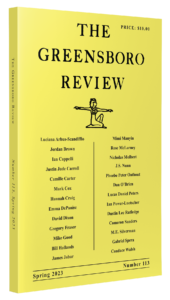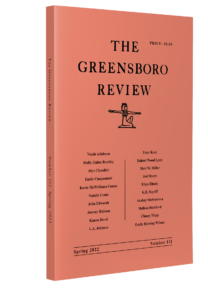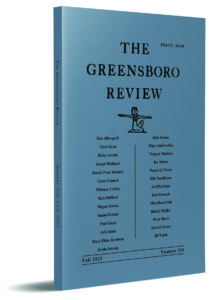Brendan Egan’s fiction and poetry have appeared in Yemassee, Threepenny Review, Witness, and other places. A native Connecticuter, he has worked as a lobster shucker, ice cream truck driver, expert chino folder, and door-to-door knife salesman. He lives in west Texas, where he teaches at Midland College and attempts to keep a garden. Egan’s story “War Rugs” won the Robert Watson Literary Prize and appears in The Greensboro Review 107.
EVAN FACKLER: First of all, Brendan, congratulations on winning the Robert Watson Literary Prize in fiction for “War Rugs.” It’s a tremendous story, ambitious and affecting both in terms of imagination and formal experimentation, which is something that drew my co-editor Patricia and I to it early on in the reading period. Have you written stories like this before?
BRENDAN EGAN: Thank you so much! I’m really honored by the recognition and so happy to see the story in Greensboro Review.
I’ve always been excited about both form and imaginative literature. Most of my stories splice threads of mythology and folklore into more or less realistic lives, and this splicing often calls attention to the formal moves that shape the narrative. But I think “War Rugs” is the first story where I’ve directly mixed genres in just this way—inserting pieces of scripts into fiction. I studied playwriting and screenwriting before writing fiction, so I often think of scenes in those terms, but the idea of actually incorporating these genres into prose probably came from reading Vi Khi Nao’s A Fish in Exile and George Saunders’s Lincoln in the Bardo, which use similar techniques, though I think to slightly different effects.
EF: There’s a great deal of fun to “War Rugs”—this sense of an entire social world embedded in the language being deployed, for instance (buttonheads versus dogfaces, Oriental versus Occidental). But this is also a story that’s taking on some pretty serious issues. Cultural identity, exile, war, prejudice. I don’t want to ask the vulgar question “where’d you get this idea?” but I am wondering if there were particular issues or events you were thinking about while you were writing?
BE: The concept of a story about magazine crews literally showed up at my door multiple times over, say, a three-year span. They weren’t selling the magazines so much as the good feeling that comes from contributing to a school fundraiser or a GoFundMe or buying a pair of Toms. Talking to these kids got me thinking about the way that personal hardship has increasingly become this sort of commodity in and of itself.
Kind of in counterpoint to this, I was trying to work out this “Death of the West”-type paranoia that has come into the mainstream through Alt-Right politics. As a blatant example, a couple months ago, the draft of an executive order was leaked from the Trump administration titled “Making Federal Buildings Great Again.” It says things like, “Federal architecture should once again inspire respect instead of bewilderment or repugnance” by sticking to the tradition of Classical principals. Really, I’ve been more bewildered and impugned by how Doric columns are still the fascist’s binkie of choice.
Of course, the bugaboo of these same paranoiacs is the migrant. Though the refugees and asylum seekers we talk about in our United States are typically coming from other places in the world, the populations that most inspired the characterization Cynocephali in the story are Afghans who have been displaced in the succession of U.S. involved wars for the last forty years. But I don’t see these characters as a direct representation of any one group from the real world as much as a representation of the lasting misunderstanding between “East” and “West” that goes back at least as far as Ctesias’s own account of the territory east of Persia.
EF: Okay. Cynocephali are mentioned by Ctesias in the Indica, which answers the question the Classics professor we recruited to help us with the Greek in the epigraph asked. (For the record, that question was: “Where in the #@$*! did you come across the Cynocephali?”) So let me pivot a little and say that for the month or so after first reading “War Rugs” in the “slush” pile (which sounds like a dirty word as I write it—maybe we should call it the “mine” or something because it’s where the gold comes from) Patricia and I went down an internet rabbit hole of “Dog Face” songs, which ends up being its own sub-genre. Phish. The Eels. Some guy called Ryan Dawson who has an entire album called “Dog-Face Girl”… maybe there are more. I guess what I’m saying is that if you were a guest on my favorite NPR show, Wait Wait…Don’t Tell Me!, and I was filling in for Peter Sagal, I would say, “We’ve invited you here today, Brendan, to play a game we’re calling…” and then Bill Kurtis would say, in that mellifluous voice of his, “Eenie meenie miny moe, catch a dog face by his toe,” or something like that, and then I’d ask you trivia about The Eels.
But really, why Cynocephali?
BE: Is it too weird to say that I’m so glad you, too, have become a little obsessed?
So, in describing what he called India, Ctesias introduced a number of concepts of “natural history” to the Western imagination. Some are accurate: parrots, falcon-assisted hunting, Indian elephants. Others are not: unicorns, manticores, river serpents, various magical wells and springs.
I’ve written some stories about a bunch of these, but the Cynocephali have always been the invention of his that most captured my fascination. For like two-thousand years, they were used as a literary authenticator for Europeans traveling in the East. Alexander claims to have captured them, Marco Polo describes their supposed settlements, and Columbus writes that he was told rumors of them in present day Haiti. St. Augustine uses them as a kind of inquiry into the definition of a human soul. The irony is that as early as the first century BC, Ctesias was thought of as a rube who presented all these second-hand yarns as fact (I’m pretty sure he was just a trickster).
In popular culture, the unicorn persists, the manticore persists, but dog-headedness kind of explodes from the middle-ages on, being applied to all kinds of outgroups and raising all kinds of questions about human dignity. Anyway, the insistence on “I saw the Cynocephali” serves as this acute example of a Classical text surviving despite itself and introducing a fundamental “othering” that we still tussle with today.
EF: Something that’s really consistent and lovely here is the way Zylina’s sensory experience of the world imbues the narrative. I’m guessing most of your stories are about us regular “button heads” and our boringly dulled senses. What was it like to write in close-third from Zylina’s perspective? Were there challenges to writing in her point-of-view?
BE: It was a lot of fun trying to imagine how a person with a dog’s hearing and smell paired with a human mind would experience the world. Particularly in moments of emotional intensity, I attempted to focus description on these senses because they are primary to canid anatomy, taking precedence over the visual sense that usually takes the lead in “buttonhead” perception.
The real challenge to writing from Zylina’s perspective was honoring the refugee experience that I haven’t had any personal access to. I wanted to avoid clichés of immigrant kid’s lives while maintaining the reality of aspirational parents, cultural ignorance in their adopted homeland, and the baggage of geopolitics that they are expected to represent. I don’t think I would have attempted this without the relative freedom of the mythopoeic space opened up by Ctesias’s inventions in the Indica.
EF: You’ve mentioned work by Ctesias and Vi Khi Nao. Were there other writers or works you thought about while you were writing “War Rugs”? In particular, I’m thinking about what you just said about trying to honor the refugee experience as a person who doesn’t have that experience. This is also a bigger question about writing across difference and representing the experience of others, I guess. How did you approach that challenge for “War Rugs”? Were there things or motifs you were conscious of trying to avoid?
BE: Calvino’s Invisible Cities, Rushdie’s The Satanic Verses, Barthelme’s story “Paraguay,” some stories from Jim Crace’s Continent, some from Helen Oyeyemi’s What is Not Yours is Not Yours, are a few of the pieces that I’ve been thinking about, particularly the way they handle slippery ideas regarding the way the West frames place and culture.
In order to get more insight on the life of migrants from Central Asia and the Subcontinent, I’ve read mostly reportage, but some of Jamil Jan Kochai’s stories and non-fiction writing have given me some particular insights on Afghan-American kids to draw from.
Things I wanted to avoid in Zylina’s story were religious extremism, helplessness, and the inability to adapt to youth culture. Media depictions of refugees often focus on the sensational and the pitiful, flattening people into endure-ers of suffering rather than full actors in their own right. For me, the best way to approach a character so unlike myself was to stay grounded in the more mundane motives that make up our shared humanity and guide most of our decision-making on a moment-by-moment basis. Zylina is a teenager. She wants love, fun, friends, independence—these aren’t culturally bound desires; they’re human ones.
EF: The ancient Greek thing runs throughout here, certainly we see it in terms of character names (Themestius, Zylina, etc.) and the Cynocephali themselves, but it’s also woven into the fabric of the story. Some early conversations I remember having with you were about formatting, since the story includes various sorts of scripts and, in an early version, several fonts and even a recipe. What Patricia and I hadn’t put together early on, though, was that the ending script is actually a Socratic Dialogue. You had to cue us in on that. Are there other nods toward Ancient Greek texts or sources that might otherwise escape the casual reader’s notice?
BE: The only specific text that I had in mind was Ctesias’s, but throughout the story, I see Zylina’s adventures as inquiries into virtue ethics of the kind that preoccupied Classical Greek philosophers. She’s realizing that like all of us, she lives in a world that’s short on justice (despite high rhetoric), but she’s trying hard to figure out what it means to live a good life.
EF: Lastly, we’re corresponding in the middle of the COVID-19 pandemic—which would certainly be affecting Zylina’s door-to-door sales if the action in “War Rugs” was happening now. How are you and your family holding up? Do you think we’re going to see a lot of quarantine stories pop up over the next year-or-so, in the pages of The New Yorker maybe?
BE: Shockingly, I’ve gotten two door-to-door pitches in the last week. One for an exterminator and another for solar panels. The sales people stood back a respectful six feet from the house, but still!
My wife, Stacy, and I are merely keeping two children under two years old alive. In whatever time we have left, we are teaching courses online, pecking at writing and related projects, and maybe squeezing in an episode of Devs before bed. My social-distancing book stack is just three deep for right now: my wife’s revised novel manuscript, and two by Jim Crace, Quarantine and The Pesthouse. I don’t have great confidence that I’ll get through all of them any time soon.
I suppose that some people are writing their pandemic stories as we speak. There’s a temptation for literature to keep pace with the hot-take media cycle, but I’m lukewarm on that at best. I think it takes time to titrate these events and pull something valuable from them. But then I’m writing about characters introduced in around 400 BC, so what do I know?

Evan Fackler is an MFA candidate in fiction at The University of North Carolina at Greensboro, where he lives with his wife and their cat, Zadie. His reviews and interviews can be found at Entropy Magazine and storySouth.






